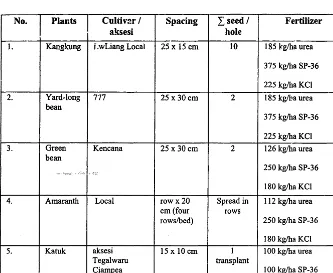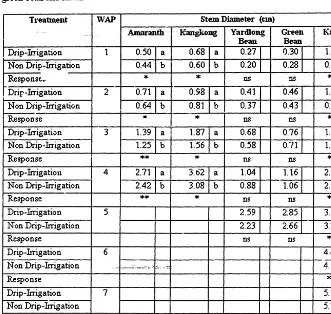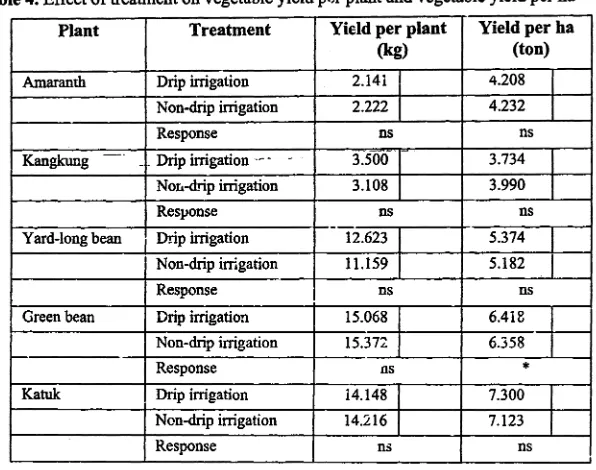8. Drip Irrigation: Will
It
Increase Yield in Traditional
Vegetable Production System?
,Anas D. Susilal, Tisna Prasetyol and Manuel C. Palada
2Abstract
Dlip irrigation systems have the highest potential water application ef-ficiency of the irrigation system used in commercial vegetable production. Drip irrigation is a tool to reduce water use, increase fertilizer efficiency, and increase profit, while simultaneously reducing the potential risk to the envi-ronment due to enrichment of surface and ground water. This research was ,- oonducted-to-e-valuate the effect of Low-Cost Drip Irrigation System (LCDS) on the yield of amaranth (Amaranthus sp.), kangkung (Ipomoea aquatica),
yard-long bean (Vigna unguiculata), green· bean (Phaseolus vulgaris), and katuk (Sauropus androgynous) grov.ib and yield during the wet sea,c;on. The experiment was conducted in the fanner site in Nanggung, Bogor from Janu-ary to May 2009. Treatments (with and without LCDS) were arranged in Ran-domized Complete Block Design with four replications (each farmer's field as one replication). The result showed DO significant response of vegetable
yield to the drip inigation application during the wet season. The experiment should be conducted in the dry season to evaluate the effectiveness of drip ir-rigation on traditional vegetable production. .
Keywords: Vegetables, low-cost drip irrigation, wet season, Ultisols
1. Introduction
In vegetable production, fertilization and irrigation are standard management practices that farmers traditionally observe to improve their vegetable produc-tion. They need to be efficient at these practices so as to maximize profit. Wa-tel-i&hecoming too scarce to waste in crop production and its availability is becoming a serious problem, even in the humid tropics, particularly in the dry
season (A VRDC, 2004).
IPlant Production Division, Department of Agronomy and Horticulture, Faculty of Agriculture, Bogor Agricultural University, n. Meranti, Komplek IPB Darmaga, Bogor 16680, Indonesia. [email protected], [email protected], Te\IFax: 0251629353
In Ute rainfed production area especially in Indonesia, vegetables nor-mally can be grown during the wet season (>200 mm/month) between De-cember and April. During the dry season «200 IJiIn/month) between May and October, vegetable farmers face shortage of irrigation water which leads to drought and decreased yields.
-Drip irrigation systems have the highest potential water application ef-ficiency of the irrigation system used in commercial vegetables production. Drip irrigation reduces water use, increases fertilizer efficiency, and improves profit, while simultaneously reduces the potential risk to the environment due to enrichment of surface and groundwater (Hochmuth, 1992). Field studies during the hot/dry season have shown thatwater use for vegetable crops can be reduced considerably with drip_irrigation. For vegetable crops like tomato, cucumber,_ 」セゥQゥ@ Qaper, yard-long bean, cabbage and pak-choi, studies have
--セィowャヲ@ that water use in drip irrigation was TUセ@ 75% less than furrow
irriga-tion. Yields achieved under drip irrigation were comparable with furrow irri-gation. Furthermore, nutrient uptake was more efficient in drip-irrigated vege-tables (A VRDC, 2004).
Low-cost diip irrigation technology has been implemented in many countiies, for example in India 8."1d Africa which have many small-scale farmers. In Indonesia, vegetable farmers have small farms averaging about 0.3 ha, with little or no access to new technology, still practicing traditional vegetable production, and with inefficient input factors, especially in- fertilizer and in water usage. Low-cost drip irrigation technology is one solution that small-scale farmers can use to increase their vegetable production through more efficient water usage, higher crop yields, reduced labo!-intensive hand-irrigation of crops and flexible systems capable of accommodating a variety of plot sizes (Andersson, 2005). These technologies are cheaper, do not re-quire electric power and are easy to install. Low-cost drip irrigation has aimed at water efficiency, plant productivity and increasing income for small-scale farmers. _
- ---This research was conducted to evaluate the effect of low-cost drip irri-gation system on the yield of amaranth (Amaranthus sp.), kangkung (Ipomoea aquatica), yard-long bean (Vigna unguiculata), green bean (Phaseolus vul-garis) and katuk (Sauropus androgynous) during the wet season.
2. Materials and Methods
emitter which were installed in the farmer plot. This experiment was arranged in Completely Randomized Block Design with four replications (each farmer field as one replication). Each of the vegetable crops was planted in a 1.5 x 5 m plot. The crop management practices for each vegetable can be seen in Ta-ble 1.
Measurements of plant height and diameter vvere conducted for kang-kung and amaranth at 1-4 weeks after planting; yard-long bean and green bean 1-5 weeks after planting; and katuk 1-7 weeks after transplanting. Total weight per plant and per ーセッエ@ was measured for kangkung and aI!laranth, total fruit weight per plant and per plot were measured for yard-long bean and green bean. Katuk yield was measured by measu...-mg the weight of shoots per plant and per plot. Analysis of variance data was calculated using SAS 8.12 (SAS Institute, Inc.).·p;testwas used to find out the significant difference be-tween treatments.
Table 1. Crop management practices: vegetables cultivar, plant spacing, number of seed per hole and fertilizer rate
No. Plants Cultiv2r I Spacing
L
seed I Fertilizeraksesi hole
1. Kang.wng LwLiang Local 25 xiS cm 10 185 I<glha urea
375 kglha SP-36
225 kglha KCI
2. Yard-long 777 25 x30cm 2 185 kg/ba urea
bean
375 kglha SP-36
225 kglha KCI
3. Green Kencana 25 x 30 cm 2 126 kglha urea
bean
250 kglha SP-36 ----. - --_.
180 kglha KCI
4. Amaranth Local rowx20 Spread in 112 kglha urea
cm (four rows
rowslbed) 250 kglha SP-36
180 kglha KCI
5. Katuk aksesi IS x 10 cm I 100 kglha urea
Tegalwaru transplant
Ciampea 100 kglha SP-36
[image:4.412.19.352.252.525.2]3. Results and Discussion
3.1 Plant height
Drip irrigation treatment did not influence plant height of amaranth at 1-4 WAP (Weeks After Planting), green bean at 1-5 WAP, and katuk at 1-7 W A.:F. However, with drip irrigation, plant height of kangkung at 1-4 W AP was higher than without drip irrigation. The same result occurred in yard-long bean, with drip irrigation increasing pla..,t height at 1-5 W AP (Table 2).
Tabie 2. Effect of drip irrigation on plant height of amaranth, kangkung, yard-long bean, green bean and katuk
Treatment WAP Plant Height (tl1'.)
-. .-- Amaranth -Kangkong Yard-long Green Katuk Bean Bean
Drip-Irrigation 1 4.86 6.30 a 19.31 a 20.33 1.330
Non Drip- 4.45 5.21 b 17.04 b 20.32 1.139
Irrigation
Response ns '"
'"
ns nsDrip-Irrigation 2 6.80 8.82 a 28.96 a 30.49 5.510
NCln Drip- 6.24 7.30 b 25.56 b 30.48 5.319
Irrigation
Response ns
'"
'" ns nsDrip-Irrigation 3 12.63 16.38 a 45.05 a 47.43 10.235
Non Drip- 11.58 13.56 b 39.76 b 47.42 10.026
Irrigation
Response ns
'"
'"
ns nsDrip-Irrigation 4 24.29 31.51 a 67.58 a 71.15 17.487
Non Drip- 22.27 26.07 b 60.53 b 71.13 17.216
Irrigation
Response ns
'"
'"
ns nsDrip-Irrigation 5 160.90 a 169.41 26.916
Non Drip- 141.99 b 169.35 26.562
Irrigation
Response .. -. --" _.
'"
ns n:;Drip-Irrigation 6 39.173
Non Drip- 38.712
Irrigation
Response os
Drip-Irrigation 7 55.091
Non Drip- 54.506
Irrigation
Response os
.. . . . .
WAP. Week After Planting: n5 : non-slgp.lflcant; ., : significant at P=O.05; U : significant at
3.3 StenB dianBeter
[image:6.416.32.363.170.484.2]Drip irrigation treatment had no influence on the stem diameter of yard-long bean at 1-5 WAP, and on green bean at 1-5 WAP. However, with drip irriga-tion the stem diameter of amaranth at 1-4 W AP, kangkung at 1-4 W AP, and katuk at 1-7 W AP were higher than without drip irrigation. The effects of drip irrigation on the stem diameter of amaranth, kangkung, yard-long bean, green bean and katuk are presented in Table 3.
Table 3. Effect of d.Tip irrigation on stem diameter of amaranth, kangkung, yard-long bean,
green bean and Jr.atuk .
Treatment WAP Stem Diameter (em)
..
--セN@ - - Amaranth- Kangkong Yardlong Green Katuk
Bean Bean
Drip-Irrigation 1 0.50 a 0.68 a 0.27 0.30 1.13 a Non Drip-:&rigation 0.44 b 0.60 b 0.20 0.28 0.80 t
Responsc..
*
*
ns ns*
Drir-:&rigation 2 0.71 a 0.98 a 0.41 0.46 1.04 a Non Drip-!rrigation 0.64 b 0.81 b 0.37 0.43 0.97 1:
Response '"'
*
ns r.s*
dイゥーセZFイゥァ。エゥセョ@ 3 1.39 a 1.87 a 0.68 0.76 1.94 a Non Drip-:&rigation 1.25 b 1.56 b 0.58 0.71 1.87 b
Respo:lse
**
*
ns ns'"'
Drip-:&rigatiou 4 2.71 a 3.62 a 1.04 1.16 2.94 a Non Drip-:&rigation 2.42 b 3.08 b 0.88 1.06 2.87 b
Response
**
*
ns ns*
dイゥセMZFイゥァ。エゥッョ@ 5 2.59 2.85 3.84 a
Non Drip-:&rigation 2.23 2.66 3.77 !:
Response ns ns
*
Drip-:&rigation 6 4.44 !
Non Drip-:&rigation NMセMセMMNL@ . ..
'4.37"1
Response
*
Drip-:&rigation 7 5.34 a
Non Drip-:&rigation 5.27 1:
Response
*
..
.
セ@.
..
. .WAP. Week After P\antmg; ns . non-slgnificant, . stgnlficant at P=O.05, ... slgnificant at
P=O.Ol
3.4 Plant yield
influ-enced the yield of green bean per ha (Table 4). With drip irrigation green bean yield (6.418 tons/ha) was higher than without drip irrigation (6.358 ton/ha). The high rainfall during the experiment in the experimental site accounted for the LCDS not being effective. To obtain significant response of vegetables to the LCDS, a similar treatment needs to be evaluated during the dry season.
Table 4. Effect of treatment on vegetable yield ーセイ@ plant and vegetable yield per ha
Plant Treatment Yield per plant Yield per ha (kg) (ton)
Amaranth Drip irrigation 2.141
I
4.208I
Non-drip irrigation 2.222
J
4.232I
Response ns ns
Kangkung -- --Drip irrigation --- .- 3.500
r
3.734I
Nor.-d.rip irrigation 3.108
I
3.990I
ReslJonse ns ns
-Yard-long bean Drip irrigation 12.623
I
5.374I
Non-drip irrigation 11.159
I
5.182I
Response ns ns
Green bean Drip irrigation 15.068
I
6.4iEI
Non-drip irrigation 15.372
I
6.358I
Response as
*
Katuk Drip irrigation 14.148
1
7.300I
Non-drip irrigation 14.216
I
7.123I
Response ns ns
Note: ns=non-significant, *significant at P=0.05, **significant at P=0.01
4. Conclusions
This experiment shows that low-cost drip irrigation did not influence the plant height of amaranth, green bean and 」ォセエオォ[@ as well as the stem diameter of yard-long bean and green bean. Low cost drip irrigation system was also not effective to support vegetable yield during the wet season.
5. Acknowledgments
References
Hochmuth, G.J. 1992 . F ertili zer manage ment for drip-irri gated vegetab les in Florida.
Han. Techn%gy, 2( 1): 27-32 .
AVRDC. 2004. Year-round vegetab le production under she lters with furrow and drip irri-gation system s . pp . 63 -68. In: AVRDC Progress Report 2004. AVRDC Publica-tion. Taivian. www .avrdc .org
Andersson , L. 2005. Low-cost drip ゥセtェァ。エ ゥッョ N@ On farm imple mentati o n in South Africa. A Thes is. Industri a l Engineering and MaIJagcc1ent, Lul ea Uni ve rs ity of Technology, Sweden.


